Wondering if tomatoes farming in Kenya per acre is profitable? In this guide, we break down the exact costs and potential earnings of growing determinate tomato varieties under irrigation in the open field. Whether you’re farming on ¼ acre or a full acre, see how much you can make from tomato farming in Kenya per acre and maximize your profits
The tomato (Solanum lycopersicum) is a fruit vegetable from the nightshade family native to South America. It is one of the major vegetables in Kenya. The majority of its yields are consumed locally in major towns like Nairobi, Eldoret, and Kisumu. It is a widely used food spice or additive together with onions, green vegetables like kale, cabbage, and African leafy vegetables. The fruits are Eaten fresh, added to salads, cooked as a vegetable, or processed into tomato paste, jam, sauce, puree, and juices.
- Benefits of tomato growing
- How profitable is tomato farming in Kenya?
- Assumptions
- Detailed Revenue Analysis
- Cost of tomato farming in Kenya
- Best open field tomato varieties in Kenya
- Soil Testing and water analysis
- How to establish a tomato nursery
- Soil Testing and water analysis
- Land Preparation & Transplanting
- Best fertilizers for tomato plants
- Staking and Training
- Crop protection
- Labor costs
- When is the best time to harvest tomato fruits?
- Marketing and Other costs
- Value addition
- Gross margin analysis for tomato farming
Benefits of tomato growing
Tomato farming will remain a highly profitable crop for commercial farmers in the region. It is because of the fruit’s health benefits, available market, and other factors as illustrated below.
- Tomatoes have many health benefits. You can reduce the risks of heart disease and various types of cancer. It is a rich source of Lycopene, vitamin C, potassium, folate, and vitamin K.
- There is a shortage of tomato supply in Kenya with some of its demand being sourced from Tanzania, Uganda and sometimes Ethiopia. It will keep growing due to urbanization.
- Tomatoes have a short maturing period compared to other staple and cash crops like maize giving you a high return on Investment for your money.
- Tomato has many types and varieties that do well in various agroecological climatic zones and can be grown in open fields, under greenhouses, or in containers for home use and sale.
Read Next; How profitable is greenhouse tomato farming in Kenya?
How profitable is tomato farming in Kenya?
In this analysis, estimate the profits per acre for growing tomatoes in Kenya. You will determine expected revenue using an average price and expected yield. Next is to deduct all the costs of production and marketing costs. The expected costs are for fertilizers, pesticides labor, and marketing based on the following assumptions.
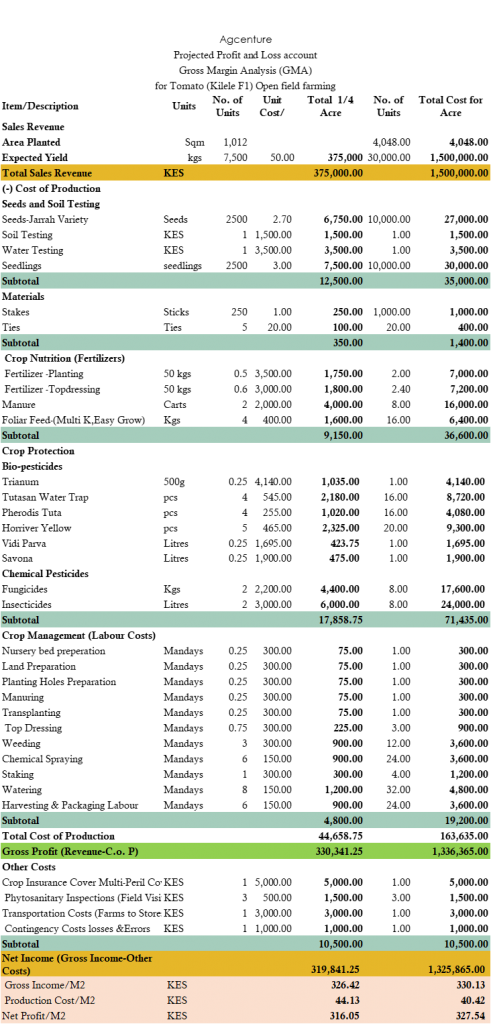
Assumptions
- This profit analysis assumes a constant selling price of KES 50 for a Kg of tomatoes throughout the harvesting period.
- The costs of farm inputs and labor etc are assumed to be the prevailing costs in the most productive tomato-growing areas in Kenya like Mwea, Ngurumani, or Subukia.
- The tomato field season lasts 16 weeks
Detailed Revenue Analysis
To get the projected revenues, get the product of the average yields and the assumed selling price per kilogram above.
Total yields and revenue
In Kenya, you can harvest 35,000 kg of tomato fruits per acre. In this analysis, we assume that 85% or 30,000 kg of the Kilele F1 variety will be marketable. You can therefore earn KES 1.5 million from an acre of tomato in Kenya under proper crop care. It is after selling each kg at KES 50 per kg. If you are a small-scale farmer, in a quarter acre of land, you would harvest 7500 kgs. After selling them at KES 50 per kg you would earn KES 375,000. The factors that may limit you from getting these are differences in variety, spacing, soil characteristics, water availability, etc.
Cost of tomato farming in Kenya
The cost of tomato farming in Kenya per acre will is KES 190,635. These expenses are used for land preparation, labor, inputs harvesting. The detailed expenses for the vegetable crop are further detailed below: –
Best open field tomato varieties in Kenya
There are various varieties of tomato variety seeds available in Kenya. You can go buy the open-pollinated or the hybrid (F1) types. The table below is a summary of the most popular determinate tomato varieties that are suitable for open-field production. It shows their maturity period in days from the transplanting date and the yields in Kg per acre.
Read Next; Best Open Field tomato varieties in Kenya
| Variety | Maturity Period (days) | Yield Potential per Acre in Tons |
|---|---|---|
| Kilele F1 | 75 | 30-35 |
| Cal J | 75-85 | 11-13 |
| Rio Grande | 75-85 | 18 |
| Eden F1 | 75 | 40-50 |
| Rambo F1 | 75 | 30 |
| Assila F1 | 75 | 23 |
| Fortune Maker F1 | 70-75 | 30-35 |
This analysis uses the Kilele F1 seed variety. It is a good choice given it’s a hybrid with higher yields. It is a determinate type suitable for dry and humid regions. Kilele F1 variety matures in 75 days after transplanting. Kilele F1 Tomato yield per acre is 30,000-35,000 kg in Kenya. Besides the ripe fruits are Firm and elongated and have a shelf life of 21 days.
Soil Testing and water analysis
The ideal ecological conditions to get big tomato fruits are as shown below for soils and rainfall. Tomato crops grow at an altitude of 0-2000 meters above sea level with temperatures of 20-25°C during the day and 15-17°C at night.
- Tomatoes require well-drained sandy, loam, or clay soils. A PH value of 6.0-7.5. Besides, the crop needs an adequate supply of nitrogen, phosphates, and potassium nutrients for optimal production. To determine if your soil is fit for tomato production do a soil testing at a cost of KES 1500.
- Tomato produces well under ample rainfall of 600 mm and above. You may need to irrigate them to improve yields. You will need clean portable water fit for consumption. To test this, you may conduct a cheap water testing service.
In addition to water and soil testing, you can carry out a pathological test to determine that your soil if free of any pests and diseases before planting.
How to establish a tomato nursery
You will need to establish tomato seedlings in a seed nursery or seed trays. You will need 50-75 g/acre of tomato seeds for your field. These will contain 10,000 seeds at a cost of KES of 2.70 per seed. You will incur additional costs for preparing the seedbed, pest control, and watering.
Alternatively, you can buy mature seedlings from a certified seed raiser. Most sell high-quality planting materials at an average cost of KES 3.00 for each.
Soil Testing and water analysis
The ideal ecological conditions to get big tomato fruits are as shown below for soils and rainfall. Tomato crops grow at an altitude of 0-2000 meters above sea level with temperatures of 20-25°C during the day and 15-17°C at night.
- Tomatoes require well-drained sandy, loam, or clay soils. A PH value of 6.0-7.5. Besides, the crop needs an adequate supply of nitrogen, phosphates, and potassium nutrients for optimal production. To determine if your soil is fit for tomato production do a soil testing at a cost of KES 1500.
- Tomato produces well under ample rainfall of 600 mm and above. You may need to irrigate them to improve yields. You will need clean portable water fit for consumption. To test this, you may conduct a cheap water testing service.
In addition to water and soil testing, you can carry out a pathological test to determine that your soil if free of any pests and diseases before planting.
Land Preparation & Transplanting
The land preparation costs include paying a lease to hire farming land, plowing, and harrowing to make fine tilth for vigorous seedling establishment. Other costs are for making planting holes or ditches. Besides, you will have to apply farmyard manure and planting fertilizer at this stage before transplanting.
Wondering how many tomato seedlings you need for an acre? The recommended spacing for tomato crops is 75 by 40 cm in wet areas and 60cm by 100 cm in dryer areas of Kenya. You will therefore need to plant 6,666 to 13,333 seedlings per acre depending on your location. The right space will give you short stocky plants with strong roots.
Best fertilizers for tomato plants
You are advised to carry out a soil test before establishing your fertilizer needs.
To prepare holes, apply 2-3 handfuls of manure in each. For an acre, you need 8 tons at a total cost of KES 16,000. You will then add 2 bottle tops of planting fertilizer like DAP, TSP, or MOP to provide potassium for root development. You will therefore need 100 kg per acre at a cost of KES 7,000.
To boost your tomato yields, you need to top-dress it twice with a nitrogenous organic or inorganic fertilizer like the CAN. The first is done at 4 weeks after transplanting at 40kg/acre. The second split is done on the 8th week at a rate of 80kg/acre. Total topdressing will cost you KES 7,200.
Apply a foliar fertilizer during the flowering period to promote vegetative bloom. You will need 16 kg of this at a cost of KES 400 each.
Staking and Training
To get quality tomato fruits, you need to stake them to avoid any contact with the soil during the wet season. The other alternative is to apply a clean mulch like hay straws.
To stake you need strong wooden stakes or bamboo sticks to act as poles. An acre needs a1000 stakes at a cost of KES 1 for each. You will need 20 plastic strips or strings to train the plant to stake.
Crop protection
Tomato crops are susceptible to many pests and diseases as listed below.
| Major Tomato Diseases | Major Tomato Pests |
| Damping-off | African Bollworm |
| Late Blight | Red Spider Mites |
| Early Blight | Tobacco Whitefly |
| Bacterial Wilt | Root-knot Nematode |
| Tomato Mosaic | Thrips |
| Blossom-end Rot | Tuta absoluta |
| Fusarium Wilt |
You will spend KES 71, 435 to control tomatoes and pests and diseases in Kenya. This analysis uses a conservative method of good agriculture practices (GAPs). It proposes the use of bio-pesticides alongside the prudential use of chemical pesticides.
Bio-pesticides suggested for your use are pheromone traps like trianum, tutasan water traps, and pherodis Tuta. The others are the use of the Horriver yellow, Vidi Parva, and Savona. The recommended chemical pesticides to spray your tomatoes are amitraz, Buprofezin Azadirachtin Imadpcroprid, etc.
Additional methods to keep diseases and pests at bay are;
- Plowing and harrowing before transplanting to kill pupae in the soil.
- Carry out regular scouting/monitoring of pest population.
- Use resistant tomato varieties and use certified disease-free seeds and seedlings.
Labor costs
Tomato is a labor-intensive crop to manage. You need KES 19,200 for labor only to grow tomatoes in an acre. It is equal to 64 man-days to manage crops from land preparation to post-harvest like sorting and grading. The workdays are for planting, watering, and topdressing. Others are for Spraying farm chemicals, transplanting, and staking them. All the anticipated costs are available in the GMA above.
When is the best time to harvest tomato fruits?
Tomato matures in 75 days on average for most varieties in Kenya. You can harvest the fruits at four maturity indices or stages based on market requirements and the distance of the market. These are.
| Tomato Maturity Index | Harvesting stage |
| Mature-Green Stage: | Up to 30% of the fruit surface has definite color break from green to yellow |
| Breaker/Turning Stage: | Up to 30% of the fruit surface has a definite color break from green to yellow |
| Pink/Light Red Stage | 30 – 90% fruit surface has pink/red color. |
| Red/Ripe Stage: | over 90% fruit surface has changed to red color. |
The ideal harvesting time is early in the morning and fruits have low temperatures. Keep them in a cool, shaded, and ventilated area. You can wipe them to remove dirt. Sort them to remove damaged and diseased fruits. You will need to grade them into big, medium, and small size fruits. Pack your Tomatoes in clean and ventilated wooden and plastic crates for transport.
Marketing and Other costs
Other costs you will incur as a tomato farmer are crop insurance, scouting costs or field visits, and transporting inputs and tomatoes to the market. You will spend around KES 10,500 for an acre.
Value addition
One of the major challenges facing tomato farmers in Kenya is high post-harvest losses and lack of market. You can reduce losses and make more profits by processing them to add value. Methods you can do this are to make jam, sauce, and pickles to earn more profits.
Gross margin analysis for tomato farming
How profitable is tomato farming in Kenya? According to this analysis, tomato farming is a huge money maker for commercial farmers. you will make a gross profit of KES 1.3 million from an acre of tomatoes in one season. As outlined, you will subtract KES 163,635 total cost from the expected gross revenue of KES 1.5 million.
To determine your gross margin per unit area, analyze gross income, production cost, and net profit with areas of an acre. The Gross margin analysis shows you will make a net profit of KES 328 per m2.
Did you Like the Post? Let us know below
Agcenture.com is your best agriculture, food & health blog.
Thank you for following us on Facebook, Twitter (X), LinkedIn, YouTube, and WhatsApp @ Agcenture for the latest updates.
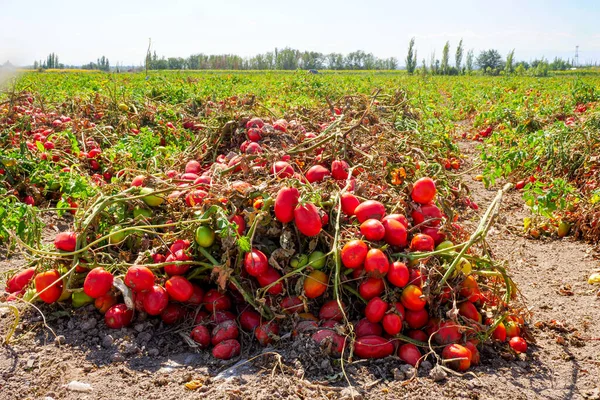
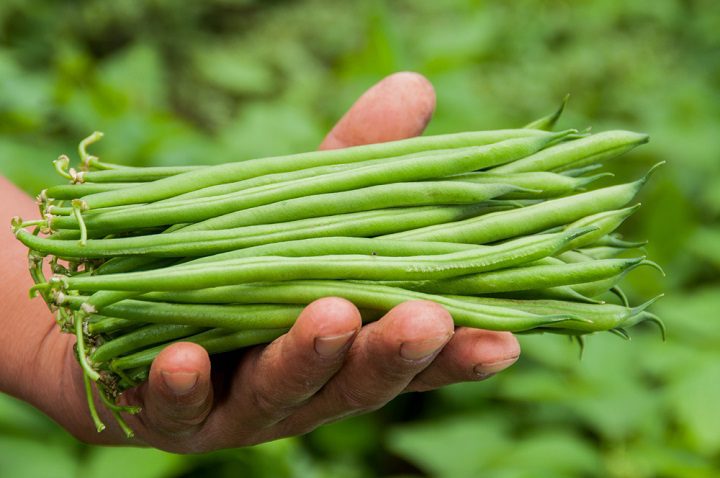
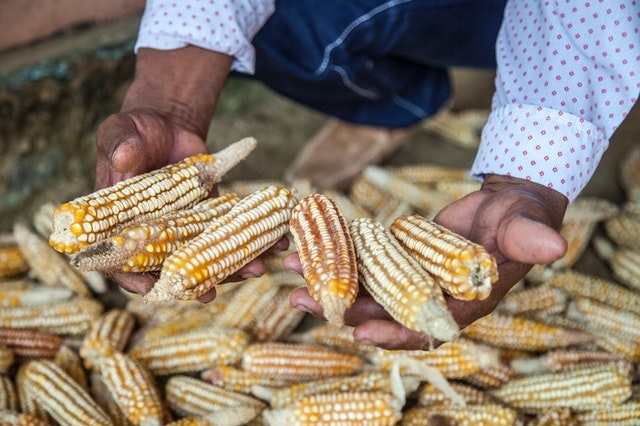
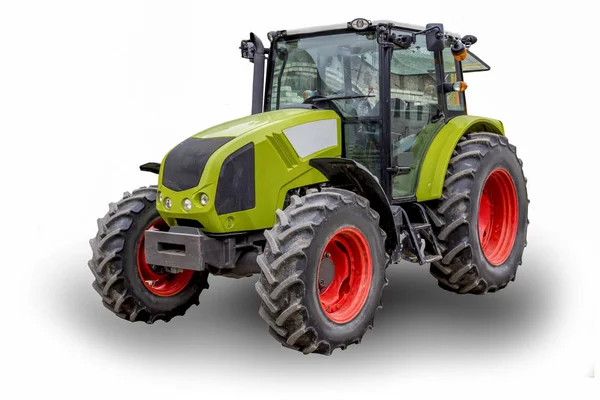
a nice piece. I wish I have a pdf version of this. It would help me alot for reference.